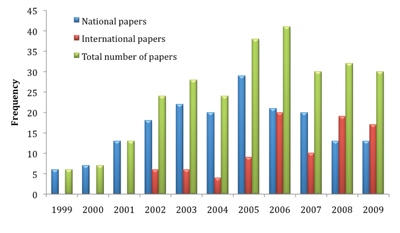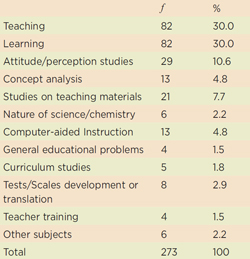|
|
Vol.
35 No. 2
March-April 2013
by Mustafa Sozbilir
Chemistry is a central part of science taught at schools around the world. Although the content and subject sequences are more or less similar, each country has developed along different paths due to unique cultural and political influences. When researching chemistry education, it is important to study not only the content of chemistry taught, but to understand the developmental path that has led each country to its individual curricula.
This feature focuses on the development of research in chemistry education in Turkey. Like many countries, Turkey has, over the last century, given special attention and importance to the teaching of chemistry. Starting with a brief introduction to the Turkish education system, the article discusses the history of chemistry education research in Turkey, including a content analysis of chemistry education research papers published at national and international levels by Turkish chemistry educators.
Turkey, with a population about 75 million (Turkish Statistical Institute, 2011) is a bridge between Europe and Asia. Following the collapse of the Ottoman Empire after World War I, the Republic of Turkey was established in 1923 under the leadership of Ataturk. Reforms were undertaken in almost every area of the state, especially in education. The Turkish education system is regarded as the most successful of the Ataturk Reforms instituted following the founding of the new state (Grossman, Onkol, & Sands, 2007). The education system was centralized by the Law of Unification of Instruction in 1924. The madrasas (formal education schools) were abolished and governance of all schools, except military schools, was transferred to the Ministry of National Education, while military schools were presided over by the Ministry of Defense. This state-supervised system is largely responsible for producing a skilled professional class, which has benefitted the social and economic welfare of the nation (Özelli, 1974).
Since its inception, the Turkish educational system has undergone further reform, including the acceptance of Latin characters as the official script in 1928 instead of Arabic characters; expansion of secularism in the social, educational, and legal aspects of education (Turkmen & Bonnstetter, 2007); implementation of new curricula (Ayas, Çepni, & Akdeniz, 1993; Turkmen & Bonnstetter, 2007); and reforms in teacher training (Turkmen, 2007). The results of these reforms have been impressive (Grossman et al., 2007).
Today, education consists of four main components: primary (ages 5–10; 5 years including one year optional pre-school education), middle school (ages 11–14; 4 years), high school (lycees or senior high schools including vocational and technical schools, ages 14–18, 4 years); and higher education (universities). Since 2011, the compulsory number of years of education is 12.
The roots of chemistry education as a discipline can be traced to several large-scale curriculum development projects in the 1960s, such as Chem Study and Chem Bond in the USA and Nuffield Chemistry in the UK. Following the disappointing results of these efforts, a hybrid discipline (Kempa, 1992; 2002) was born as chemists and educators began trying to understand how students learn chemistry so they could design its teaching in a way that improved learning outcomes. Today, chemistry education is a well-developed and accepted research discipline in developed countries, but has yet to spread throughout the world.
| Figure 1. The number of chemistry education papers published by Turkish researchers in national and international journals. |
 |
In Turkey, there was very little research in chemistry education before 1990. The bibliography compiled by Bağ, Kara, and Uşak (2002) and other content analysis studies (Sozbilir and Canpolat, 2006; Sozbilir and Kutu, 2008; Sozbilir, Kutu and Yasar, 2012) suggest that before then, only a few publications focused on chemistry education research had been published. Although during the Republican Era numerous education reforms were implemented and applied with great excitement, chemistry education did not improve (Özden, 2007). The most recent comprehensive reform effort was the multi-phased National Education Development Project (NEDP) of 1990, intended to improve the quality of teacher education in Turkey (Sozbilir, Kutu and Yasar, 2012). As a result of NEDP, programs of schools of teacher education (the name of courses and academic structures of teacher training colleges) and curricula (the content of courses) have become unique in the nationwide in 1998 (Türkmen, 2007). This reform increased interest in chemistry education research in Turkey. As figure 1 shows, research papers on chemistry education started to appear in national journals in 1999 and then, in the following years, increased dramatically at the national (Sozbilir, Kutu and Yasar, 2011; in press) and international levels (Chang, Chang, & Tseng, 2010; Lee, Wu, & Tsai, 2009). The total number of papers are still quite low compared to the number of people who are employed in chemistry education.1
| Figure 2. Comparison of the research method used in chemistry education research papers in Turkish and international publications. |
 |
Following the increasing interest in chemistry education research, the Higher Education Council of Turkey provided international postgraduate education fellowships to a handful of students, most of whom studied in the USA and UK, with a few in France and Germany. Since 2000, those Ph.D. candidates have completed their studies and returned to Turkey. Figure 1 clearly shows their impact, with the number of papers published in international journals increasing steadily since 2002, while most of the papers before 2006 were published in national journals. In recent years, more papers have been published in international than national journals. The reason for this is a state policy that makes academic advancement contingent on international publication.
 |
Table 1. Frequently studied subject areas in chemistry education research papers by Turkish chemistry
educators. |
As seen from the table 1, most of the research focused on teaching, learning, and attitude and perception issues in chemistry education, which is similar to international trends. However, overall a broader range of issues were covered compared to international studies.
There are also differences in the research methods used by Turkish chemistry education researchers compared to their international counterparts, as reported by Sozbilir, Kutu, and Yasar (2011). Turkish researchers mostly relied on quantitative research methods, while international researchers tended to use qualitative methods. This may be because qualitative research methods are newer than quantitative methods. In addition, most of the quantitative research is descriptive, such as survey studies that are relatively easy to conduct, analyze, and report compared to qualitative papers that demand strong research and English skills.
The number of journals publishing science/chemistry education research in Turkey has also increased. New national and international journals inclue EURASIA Journal of Mathematics, Science and Technology Education, Eurasian Journal of Physics and Chemistry Education, Journal of Turkish Science Education, and The International Journal of Environmental and Science Education.
Although there have been significant improvements in the quality of chemistry education research taking place in Turkey, the field has yet to become robust. In particular, it would be helpful if more of the research could focus on how to improve chemistry education within Turkey.
Mustafa Sozbilir <[email protected]> is an associate professor of chemistry education at the Kazım Karabekir Education Faculty of Atatürk University Erzurum, Turkey and a member of the IUPAC Committee on Chemistry Education. He is the convenor, with F. Gulay Kirbaslar, Musa Sahin, of the IUPAC 2013 Congress Symposium “Education in Chemistry: Innovative Teaching and Learning Tools.”
Ayas, A., Çepni, S. & Akdeniz, A.R. (1993). Science Education, 77(4), 433–440.
Bağ, H., Kara, İ., & Uşak, M. (2002). Pamukkale University Education Faculty Journal, 2(12), 48–59. [Online] http://egitimdergi.pamukkale.edu.tr, retrieved on 11 January 2010.
Chang, Y.H., Chang, C.Y., & Tseng, Y.H. (2010). Journal of Science Education and Technology, 19(4), 315–331.
Grossman, G.M., Onkol, P.E. & Sands, M. (2007). International Journal of Educational Development, 27, 138–150.
Johnstone, A.H. (1993). Journal of Chemical Education, 70(9), 701–705.
Kempa, R.F. (1992). Research in Assessment X (pp.2–31). London: Royal Society of Chemistry.
Kempa, R.F. (2002). Chemistry Education: Research and Practice in Europe, 3(3), 327–343.
Lee, M.H., Wu, Y.T., & Tsai, C.C. (2009). International Journal of Science Education, 31(15), 1999–2020.
Özden, M. (2007). Eurasia Journal of Mathematics, Science & Technology Education, 3(2), 157–161. [Online] www.ejmste.com.
Özelli, M.T. (1974). International Journal of Middle East Studies, 5(1), 77–92.
Sozbilir, M. & Canpolat, N. (2006). In M. Bahar. (Ed) Fen ve teknoloji öğretimi [Teaching science and technology] (pp. 417–432). Ankara, Turkey: PegemA Publishers.
Sozbilir, M. & Kutu, H. (2008). Essays in Education, Special Issue, 1–22. [Online] www.usca.edu/essays, retrieved on 2 January 2010.
Sozbilir, M., Kutu, H., & Yasar, M.D. (in press). In M. Sozbilir (Ed.). Türkiye'de Kimya Eğitimi [Chemistry Education in Turkey]. Istanbul: Turkish Chemical Society.
Sozbilir, M., Kutu, H., & Yasar, M. D. (2011, August). Paper presented at the IUPAC 43rd World Chemistry Congress, San Juan, Puerto Rico.
Sozbilir, M., Kutu, H., & Yasar, M.D. (2012). In D. Jorde & J. Dillon (Eds). Science Education Research and Practice in Europe: Retrospective and Prospective (pp.341–374). Rotterdam: Sense Publishers.
Turkish Statistical Institute (2011). Retrieved from www.tuik.gov.tr/VeriBilgi.do?alt_id=39 on 1 December 2012.
Turkmen, L. & Bonnstetter, R.J. (2007). Science Education International, 18(1), 139–151.
Türkmen, L. (2007). Eurasia Journal of Mathematics, Science & Technology Education, 3(4), 327–341. www.ejmste.com.
Page
last modified 11 March 2013.
Copyright © 2003-2013 International Union of Pure and Applied Chemistry.
Questions regarding the website, please contact [email protected]
|